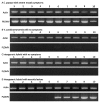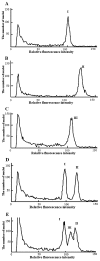Development of plants resistant to Papaya leaf distortion mosaic virus by intergeneric hybridization between Carica papaya and Vasconcellea cundinamarcensis
- PMID: 28163589
- PMCID: PMC5282761
- DOI: 10.1270/jsbbs.16107
Development of plants resistant to Papaya leaf distortion mosaic virus by intergeneric hybridization between Carica papaya and Vasconcellea cundinamarcensis
Abstract
In this study, we confirmed that Vasconcellea cundinamarcensis resists Papaya leaf distortion mosaic virus (PLDMV), and used it to produce intergeneric hybrids with Carica papaya. From the cross between C. papaya and V. cundinamarcensis, we obtained 147 seeds with embryos. Though C. papaya is a monoembryonic plant, multiple embryos were observed in all 147 seeds. We produced 218 plants from 28 seeds by means of embryo-rescue culture. All plants had pubescence on their petioles and stems characteristic of V. cundinamarcensis. Flow cytometry and PCR of 28 plants confirmed they were intergeneric hybrids. To evaluate virus resistance, mechanical inoculation of PLDMV was carried out. The test showed that 41 of 134 intergeneric hybrid plants showed no symptoms and were resistant. The remaining 93 hybrids showed necrotic lesions on the younger leaves than the inoculated leaves. In most of the 93 hybrids, the necrotic lesions enclosed the virus and prevented further spread. These results suggest that the intergeneric hybrids will be valuable material for PLDMV-resistant papaya breeding.
Keywords: embryo rescue; flow cytometric analysis; monodehydroascorbate reductase gene; trnD-trnY.
Figures





Similar articles
-
Generation of hermaphrodite transgenic papaya lines with virus resistance via transformation of somatic embryos derived from adventitious roots of in vitro shoots.Transgenic Res. 2010 Aug;19(4):621-35. doi: 10.1007/s11248-009-9344-2. Epub 2009 Nov 27. Transgenic Res. 2010. PMID: 19943109
-
Potential threat of a new pathotype of Papaya leaf distortion mosaic virus infecting transgenic papaya resistant to Papaya ringspot virus.Phytopathology. 2008 Jul;98(7):848-56. doi: 10.1094/PHYTO-98-7-0848. Phytopathology. 2008. PMID: 18943262
-
Simultaneous detection of papaya ringspot virus, papaya leaf distortion mosaic virus, and papaya mosaic virus by multiplex real-time reverse transcription PCR.Acta Virol. 2015 Dec;59(4):380-8. doi: 10.4149/av_2015_04_380. Acta Virol. 2015. PMID: 26666186
-
Battle of Three: The Curious Case of Papaya Sticky Disease.Plant Dis. 2020 Nov;104(11):2754-2763. doi: 10.1094/PDIS-12-19-2622-FE. Epub 2020 Aug 19. Plant Dis. 2020. PMID: 32813628 Review.
-
Papaya Sticky Disease Caused by Virus "Couples": A Challenge for Disease Detection and Management.Plant Dis. 2023 Jun;107(6):1649-1663. doi: 10.1094/PDIS-11-22-2565-FE. Epub 2023 Jun 8. Plant Dis. 2023. PMID: 36572970 Review.
Cited by
-
Genomic insights into the domestication and genetic basis of yield in papaya.Hortic Res. 2025 Feb 17;12(5):uhaf045. doi: 10.1093/hr/uhaf045. eCollection 2025 May. Hortic Res. 2025. PMID: 40236729 Free PMC article.
References
-
- Bau, H.J., Kung, Y.J., Raja, J.A.J., Chan, S.J., Chen, K.C., Chen, Y.K., Wu, H.W. and Yeh, S.D. (2008) Potential threat of a new pathotype of Papaya leaf distortion mosaic virus infecting transgenic papaya resistant to Papaya ringspot virus. Phytopathol. 98: 848–856. - PubMed
-
- Chen, M.H., Chen, C.C., Wang, D.N. and Chen, F.C. (1991) Somatic embryogenesis and plant regeneration from immature embryos of Carica papaya × Carica cauliflora cultured in vitro. Can. J. Bot. 69: 1913–1918.
-
- Conover, R.A. (1964) Mild mosaic and faint mottle ringspot, two papaya virus diseases of minor importance in Florida. Pro. Fla. State Hort. Soc. 77: 444–448.
-
- Dillon, S., Ramage, C., Drew, R. and Ashmore, S. (2005) Genetic mapping of a PRSV-P resistance gene in “highland papaya” based on inheritance of RAF markers. Euphytica 145: 11–23.
LinkOut - more resources
Full Text Sources
Other Literature Sources
